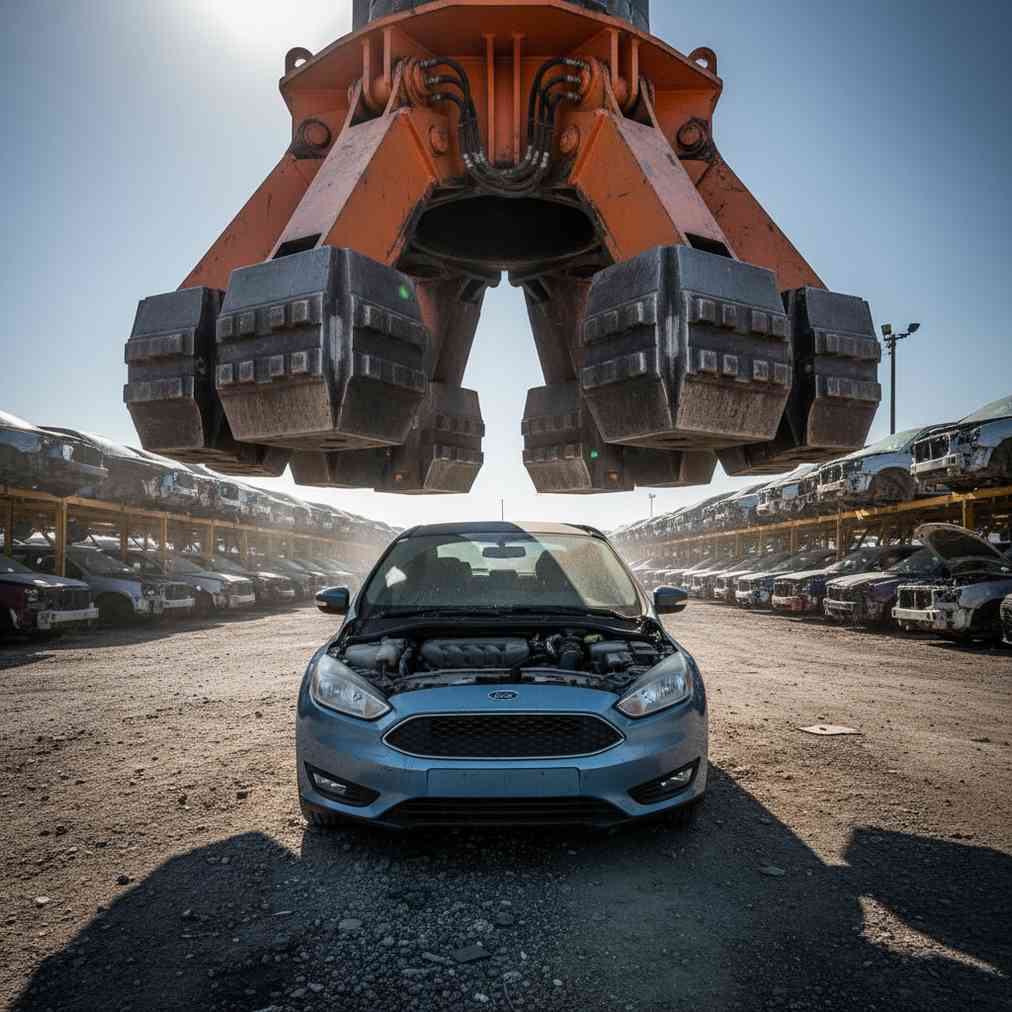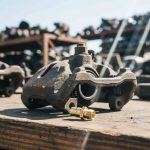Understanding Salvage Car Lifecycle: From Arrival to Final Destination
The journey of a salvage car through an auto recycling facility is a fascinating process that transforms what many consider “junk” into valuable resources. Modern salvage yards near me have evolved far beyond the stereotypical image of chaotic junkyards, becoming sophisticated operations focused on environmental compliance and resource recovery.
This comprehensive lifecycle ensures that approximately 80% of a vehicle’s materials are recycled or reused, making automotive recycling one of the most successful recycling industries in the world. Understanding this process helps consumers make informed decisions about both purchasing used auto parts and disposing of their end-of-life vehicles.
Stage 1: Arrival and Initial Assessment
When a vehicle arrives at a licensed auto recycling facility, it begins its transformation from a totaled car into a source of reusable parts and raw materials. The arrival process is highly structured and regulated to ensure proper documentation and legal compliance.
Documentation and Legal Requirements
Every vehicle entering the facility undergoes thorough documentation. The Vehicle Identification Number (VIN) is recorded and verified against databases to ensure the vehicle isn’t stolen. This creates a legal paper trail that follows the vehicle throughout its lifecycle.
- Insurance totals: Vehicles deemed total losses by insurance companies
- Direct owner sales: Cars sold directly by owners who no longer want them
- Fleet disposals: Commercial vehicles at the end of their service life
- Accident vehicles: Cars damaged beyond economical repair
Professional Assessment Process
Trained professionals inspect each vehicle to determine its potential value. This assessment considers the vehicle’s make, model, year, condition, and current market demand for its parts. Popular models like Honda Civics and Ford F-150s typically have higher part demand and may remain in the yard longer.
The assessment team uses advanced data systems to catalog valuable parts electronically. This digital inventory connects to online systems, allowing customers to search for specific parts before visiting the yard.
Stage 2: Environmental Compliance and Depollution
The depollution stage represents the most critical phase for environmental protection and worker safety. This process must be completed before any other work begins on the vehicle, ensuring compliance with EPA regulations and preventing environmental contamination.
Systematic Fluid Removal Process
| Removal Order | Fluid Type | Disposal/Recycling Method |
|---|---|---|
| 1st | Battery | Core recycling for lead recovery |
| 2nd | Refrigerants (A/C) | EPA-certified recovery equipment |
| 3rd | Gasoline/Diesel | Reused in yard fleet or recycled |
| 4th | Engine Oil | Re-refined into new motor oil |
| 5th | Antifreeze | Filtered and resold or recycled |
| 6th | Transmission Fluid | Recycled or disposed properly |
| 7th | Brake/Power Steering Fluids | Hazardous waste disposal |
Modern depollution equipment has revolutionized this process, making it faster, safer, and more efficient. Specialized automated systems can drain multiple fluids simultaneously while preventing spills and worker exposure to hazardous materials.
Additional Hazardous Material Removal
Airbag deployment and removal requires special training and equipment. Undeployed airbags contain explosive charges that must be safely neutralized. Mercury switches, found in older vehicles, require careful removal and disposal as hazardous waste.
“Proper depollution is vital for preventing hazardous fluid leakage into soil and waterways, ensuring worker safety, and maintaining compliance with waste disposal regulations. It also leads to better-quality scrap metal, which increases resale value.”
Stage 3: Parts Harvesting and Inventory Management
After depollution, the vehicle enters the parts harvesting phase, where valuable components are systematically removed for resale. This stage represents the primary revenue stream for most salvage operations, as reusable parts often hold significantly more value than raw scrap metal.
High-Value Part Removal Priority
Professional dismantlers first remove the most valuable and marketable parts. These typically include:
- Engines and transmissions: Stored in climate-controlled warehouses
- Electronic control modules: High-demand, compact parts
- Catalytic converters: Valuable for precious metal content
- Wheels and tires: Popular among budget-conscious consumers
- Body panels: Fenders, bumpers, and doors in good condition
- Lighting assemblies: Headlights, taillights, and turn signals
- Interior components: Seats, dashboards, and trim pieces
The rise of data science trends has enabled yards to better predict which parts will be in demand, optimizing their inventory management strategies.
The U-Pull-It Model
After high-value parts are removed, vehicles are placed in the yard for customer self-service. The u-pull-it model allows customers to remove parts themselves at significantly reduced prices. This system benefits both the yard and customers by reducing labor costs while providing affordable parts.
Vehicles are strategically placed in organized rows with clear location markers. Advanced yards use GPS coordinates and mobile apps to help customers locate specific vehicles quickly. This systematic approach maximizes space utilization and customer satisfaction.
Stage 4: Yard Availability Period
The duration a vehicle remains available for parts varies significantly based on multiple factors. Understanding these timeframes helps customers plan their visits and manage expectations for part availability.
| Yard Type | Typical Duration | Factors Influencing Time |
|---|---|---|
| High-turnover operations | 30 days or less | Space constraints, quick processing |
| Standard operations | 2-3 months | Balanced approach to sales and space |
| Specialty/classic yards | 9 months to 1 year | Rare models, collector demand |
Factors Affecting Availability Duration
- Vehicle popularity: Common models like Toyota Camrys move parts faster
- Part demand: High-demand vehicles may be stripped quickly
- Yard capacity: Space limitations force faster turnover
- Seasonal factors: Winter weather may slow customer traffic
- Economic conditions: Recessions increase demand for used parts
Modern inventory management systems help yards optimize these timeframes. Customers can sign up for alerts when specific vehicles arrive, ensuring they get first access to desired parts.
Stage 5: Final Processing and Metal Recovery
When a vehicle has served its purpose in the parts yard, it enters the final phase of its lifecycle. This stage focuses on recovering the maximum value from remaining materials while ensuring environmental compliance.
Crushing and Volume Reduction
Heavy machinery compresses vehicle hulks into compact cubes, reducing volume by up to 75%. This compression makes transportation to shredding facilities more cost-effective and environmentally friendly by reducing the number of truck loads required.
Modern car crushers can process multiple vehicles simultaneously, with some operations handling dozens of cars per day. The crushing process is carefully controlled to ensure worker safety and prevent the release of any remaining fluids.
Shredding and Material Separation
Crushed hulks are transported to specialized shredding facilities equipped with high-speed rotating hammers that tear vehicles apart in seconds. These industrial shredders can process up to 400 tons of scrap per hour, making them incredibly efficient.
The shredding process separates materials using sophisticated technology:
- Magnetic separation: Removes ferrous metals (steel, iron)
- Eddy current separation: Recovers non-ferrous metals (aluminum, copper)
- Air classification: Separates light materials from heavy ones
- Density separation: Further refines material streams
Material Recovery Statistics
| Material Type | Recovery Rate | End Use |
|---|---|---|
| Steel | 95-98% | New vehicle manufacturing, construction |
| Aluminum | 90-95% | New vehicles, packaging, aerospace |
| Copper | 85-90% | Electrical wiring, plumbing |
| Plastics | 20-25% | Automotive parts, consumer goods |
The remaining materials, called Automotive Shredder Residue (ASR), consist primarily of plastics, glass, rubber, and upholstery. While historically sent to landfills, new technologies are finding ways to process ASR into useful products or energy.
Environmental Impact and Sustainability Benefits
The salvage car lifecycle represents one of the most successful examples of circular economy principles in action. The environmental benefits extend far beyond simple waste reduction, contributing significantly to resource conservation and emission reduction.
Quantified Environmental Benefits
- Greenhouse gas reduction: Recycling one ton of steel reduces emissions by approximately one ton
- Air pollution reduction: 86% less air pollution compared to producing new steel
- Water pollution reduction: 76% less water pollution than new steel production
- Energy savings: Recycling steel uses 60% less energy than primary production
- Raw material conservation: Reduces need for iron ore mining and processing
“Being in the used auto parts game has opened my eyes to the beauty of automotive recycling. It’s one of the few industries that recycles a huge percentage of the materials that they purchase.”
The Reuse Hierarchy in Action
The salvage car lifecycle perfectly demonstrates the “Reduce, Reuse, Recycle” hierarchy. Parts reuse represents the highest form of resource recovery, as noted by industry experts: “This is the best way to recycle because you are not putting energy into reprocessing and making a new item, people are just reusing the old one.”
This approach has made automotive recycling a leader in sustainability, with the industry recycling more materials by weight than newspapers, aluminum cans, and glass bottles combined.
Modern Technology and Industry Evolution
The transformation from traditional “junkyards” to modern auto recycling facilities reflects broader technological and regulatory changes. Today’s operations bear little resemblance to the stereotype of chaotic, environmentally problematic scrapyards.
Technological Advances
Modern salvage yards leverage technology throughout the vehicle lifecycle. Advanced data science applications help predict part demand, optimize inventory, and streamline operations.
- Digital inventory systems: Real-time parts tracking and customer access
- Automated depollution equipment: Faster, safer fluid removal
- GPS vehicle location: Helps customers find specific cars quickly
- Mobile apps: Allow customers to search inventory remotely
- Electronic payment systems: Streamline transactions and reduce theft
Regulatory Compliance and Standards
Modern facilities operate under strict environmental regulations that govern every aspect of the salvage car lifecycle. These standards ensure that operations protect groundwater, air quality, and worker safety while maximizing resource recovery.
Licensed facilities must maintain detailed records of fluid disposal, parts sales, and final vehicle disposition. This documentation creates transparency and accountability throughout the process.
Economic Impact and Market Dynamics
The salvage car lifecycle supports a robust economic ecosystem that benefits consumers, businesses, and the environment. Understanding these economics helps explain why this industry has grown and evolved so successfully.
Revenue Streams Throughout the Lifecycle
| Revenue Source | Percentage of Total Revenue | Key Factors |
|---|---|---|
| Used parts sales | 60-70% | Part demand, vehicle popularity |
| Scrap metal sales | 20-25% | Metal prices, processing efficiency |
| Core parts | 8-12% | Remanufacturing demand |
| Fluids recovery | 2-5% | Processing capabilities |
The economic model prioritizes parts reuse over immediate crushing because reusable parts often hold more value than raw scrap metal, especially for popular or vintage models. This economic incentive aligns perfectly with environmental goals.
Consumer Benefits
Consumers benefit significantly from the salvage car lifecycle through access to affordable parts. Used auto parts typically cost 30-70% less than new parts while providing similar functionality and reliability.
This cost savings makes vehicle repairs more accessible, keeping older vehicles on the road longer and reducing the demand for new vehicle production.
Future Trends and Challenges
The salvage car lifecycle continues evolving as new technologies and regulations shape the industry. Electric vehicles, advanced materials, and changing consumer preferences will influence how this process develops.
Electric Vehicle Impact
Electric vehicles present both opportunities and challenges for the salvage industry. High-voltage batteries require specialized handling and processing, but they also contain valuable materials like lithium, cobalt, and rare earth elements.
The industry is investing in new equipment and training to safely process electric vehicles while maximizing the recovery of these valuable materials. Research trends in 2025 suggest continued focus on battery recycling technologies.
Advanced Materials and Processing
Modern vehicles contain increasing amounts of advanced materials like carbon fiber, advanced high-strength steels, and complex composites. Processing these materials requires new separation and recovery technologies.
Machine learning applications are being developed to optimize material sorting and quality assessment, potentially revolutionizing how salvage yards process vehicles.
Maximizing Value from Your End-of-Life Vehicle
Understanding the salvage car lifecycle helps vehicle owners make informed decisions when their cars reach the end of their useful life. Whether selling to a salvage yard or donating to charity, knowing this process ensures you get fair value.
If you’re considering selling your vehicle, getting an instant quote for your junk car can help you understand its value in the current market. Factors like make, model, year, condition, and current scrap metal prices all influence the final offer.
Preparing Your Vehicle for Sale
- Remove personal items: Check all compartments thoroughly
- Gather documentation: Title, registration, and keys if available
- Assess valuable parts: Note any aftermarket additions or recent repairs
- Consider part removal: High-value parts might be sold separately
- Compare offers: Get quotes from multiple buyers
Conclusion: The Circular Economy in Action
The lifecycle of a salvage car represents one of the most successful examples of circular economy principles in practice. From the moment a vehicle arrives at a recycling facility to its final transformation into new products, every stage of this process contributes to environmental protection and resource conservation.
This sophisticated system transforms what might otherwise be waste into valuable resources, supporting both economic activity and environmental sustainability. The industry’s evolution from simple junkyards to high-tech recycling facilities demonstrates how regulatory compliance and market forces can align to create positive outcomes.
As the automotive industry continues evolving with electric vehicles and advanced materials, the salvage car lifecycle will adapt and innovate. However, the fundamental principles of maximizing reuse, ensuring environmental protection, and providing economic value will remain at its core.
Whether you’re a consumer looking for affordable parts, a vehicle owner planning for end-of-life disposal, or simply someone interested in sustainable practices, understanding this lifecycle helps you make informed decisions that benefit both your wallet and the environment. The next time you see a salvage yard, remember that you’re looking at a sophisticated operation that plays a crucial role in our sustainable future.





Leave a Reply
You must be logged in to post a comment.